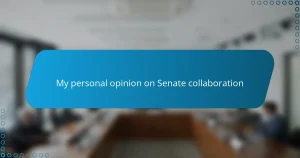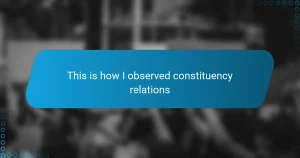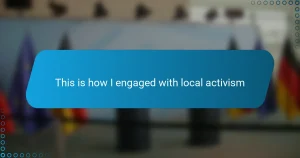Key takeaways
- Media consumption and social identity significantly influence political polarization, leading to divided realities and hardened opinions.
- Emotional responses like fear and anger often escalate conflicts, making constructive dialogue challenging.
- Effective strategies include active listening, focusing on shared values, and recognizing when to disengage to preserve relationships.
- Personal growth involves overcoming biases, acknowledging the individual stories behind opposing views, and managing emotions to foster better communication.
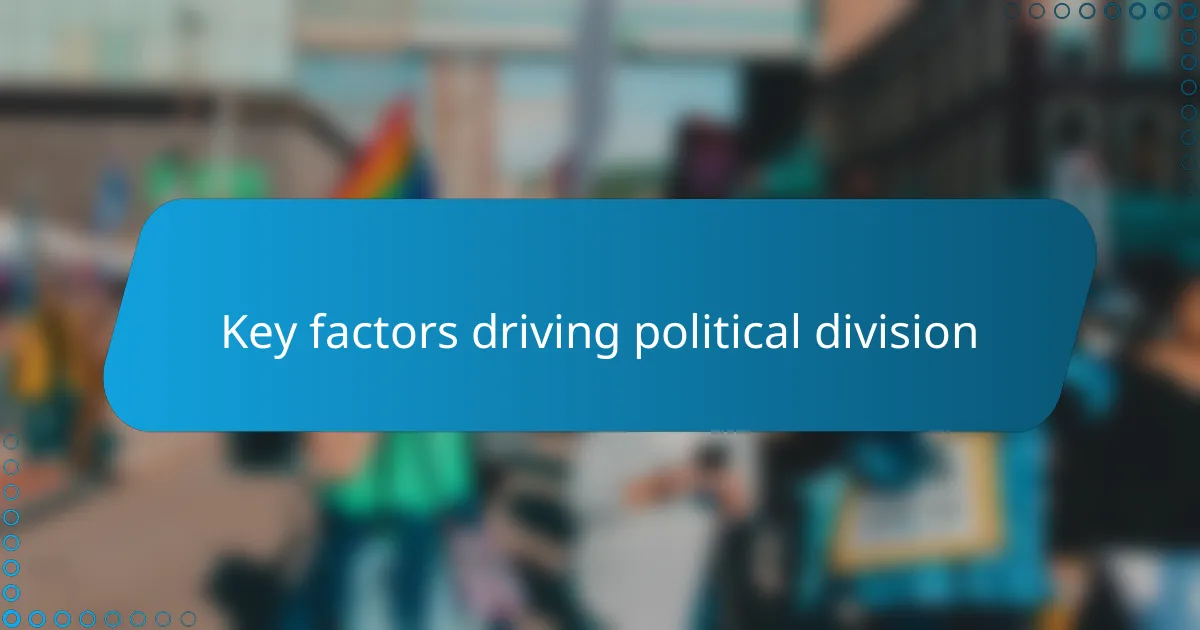
Key factors driving political division
One thing I noticed firsthand during party polarization events is how much media consumption shapes our perspectives. When everyone around me seemed to be tuning into vastly different news sources, it became clear that we were living in separate realities. Have you ever felt that tension when a simple news story triggers drastically different reactions within your own circle?
Social identity also plays a huge role. I remember feeling a strong pull to align with certain groups, not just because of shared beliefs, but because of a need to belong. Isn’t it fascinating—and a bit unsettling—how much loyalty to “our side” can harden opinions and deepen divides?
Finally, emotional response can’t be underestimated. I saw how fear, anger, and frustration often fueled the most intense disagreements. When people are scared or feel threatened, do they ever really listen to opposing views, or is the priority just protecting their own worldview? These emotions, in my experience, act like fuel that keeps the polarization fire burning.
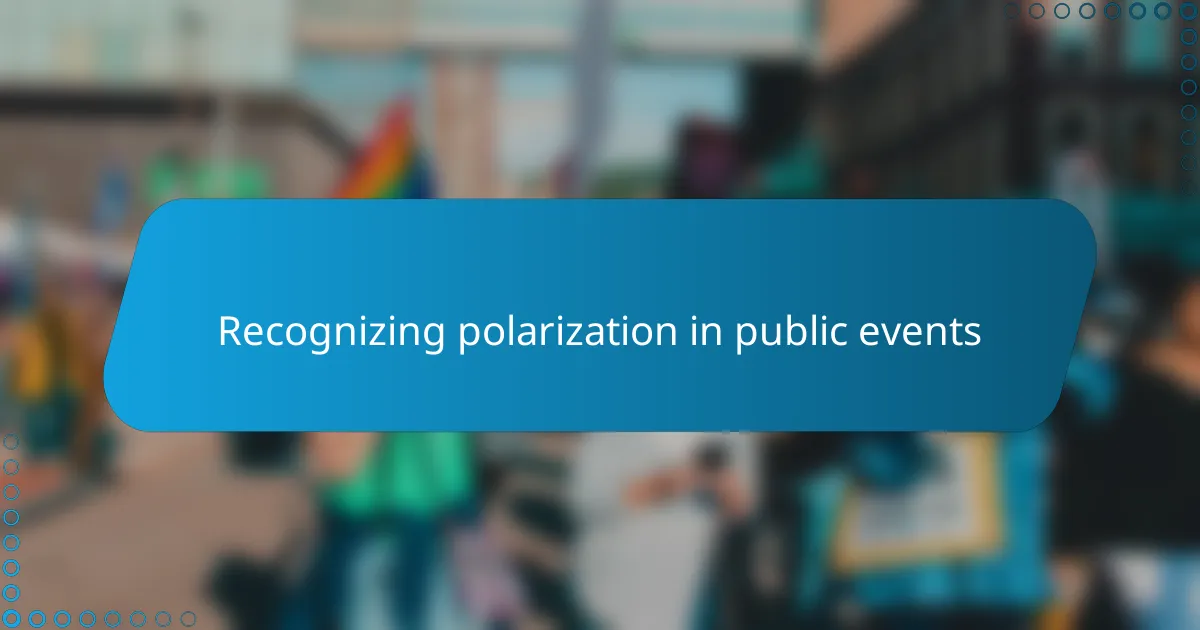
Recognizing polarization in public events
What struck me during those polarized events was how quickly conversations shifted from calm exchanges to heated debates. It felt like a switch flipped whenever politics came up, and people instantly grouped themselves, ready to defend or attack. Have you noticed how even neutral topics can suddenly become battlegrounds once political identities are involved?
Sometimes, it was subtle—a tense silence after someone expressed a conflicting opinion or the quick change of subject when things got uncomfortable. Other times, the division was blatant, with people openly questioning each other’s motives or values. In those moments, I realized that polarization isn’t just about different ideas; it’s about feeling personally challenged.
I recall attending a community meeting where a simple discussion about local policies spiraled into shouting matches. The room became divided in an instant, and it was clear that deeper political loyalties overshadowed the actual issues. Have you ever been in a space where unity seemed impossible because people were more invested in ‘winning’ than understanding? That’s the harsh reality of recognizing polarization in public events.
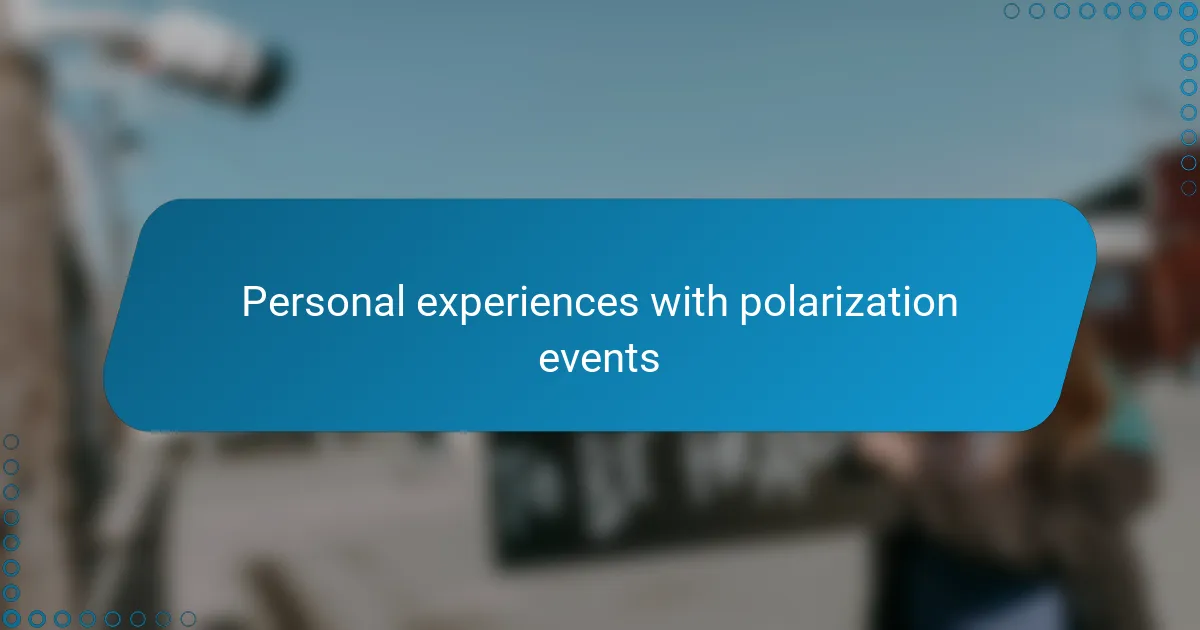
Personal experiences with polarization events
I remember one family gathering that quickly turned tense when politics entered the conversation. It was surprising—and a bit disheartening—to see how a few words triggered old grievances and silent stares. Have you ever experienced that awkward moment when a casual chat feels like walking on eggshells?
At work, I noticed how colleagues would cluster based on their political leanings, often avoiding anyone who didn’t share their views. It made everyday interactions uncomfortable, almost like navigating a minefield. How often do we underestimate the personal strain these divisions cause in places where we need cooperation the most?
There was also a time when I tried to mediate a discussion among friends with opposing views. Despite my efforts, emotions ran high, and listening seemed impossible. It struck me how easily fear and frustration overshadow logic, leaving little room for common ground. Isn’t it challenging to find calm in such stormy exchanges?
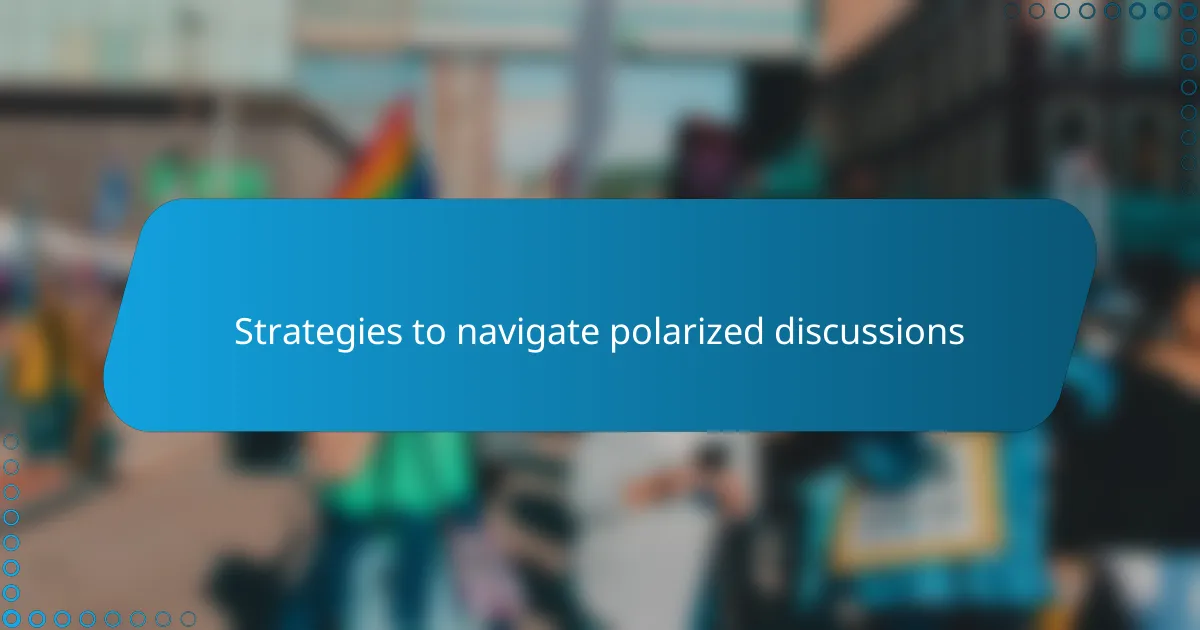
Strategies to navigate polarized discussions
One approach I found effective is stepping back and really listening—without immediately jumping in to debate. It’s surprising how much that pause can defuse tension and open space for understanding. Have you ever tried just asking someone to explain their viewpoint fully before responding? It changes the dynamic in a way that feels almost humanizing.
Another strategy I relied on was steering conversations toward shared values rather than differences. Focusing on what we care about—like fairness or safety—sometimes cuts through the noise of party labels. I noticed that when I highlighted common goals, even the most polarized chats found moments of agreement, reminding us that the divide isn’t always as wide as it seems.
Sometimes, I admitted to myself that some discussions weren’t worth the emotional toll. Walking away or agreeing to disagree felt like strength, not defeat. After all, wouldn’t you agree that preserving relationships can be more important than winning every argument? Knowing when to pause has been key to surviving—and even thriving—in polarized environments.
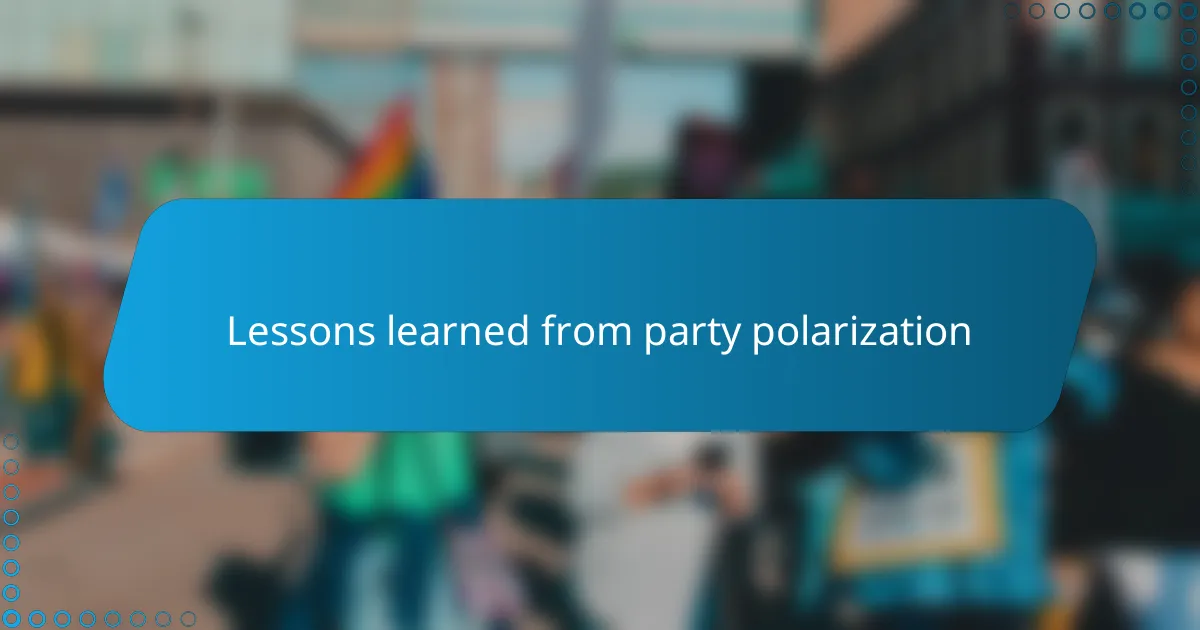
Lessons learned from party polarization
I learned that polarization often blinds us to the human behind the opposing view. When I stopped seeing people as “enemies” and more as individuals shaped by different experiences, the sharp edges of disagreement softened. Have you ever tried to imagine someone’s story before jumping into a debate? It changes everything.
Another lesson is how easy it is to get trapped in an echo chamber. I caught myself repeating talking points without questioning their origin or accuracy, just to fit in with my group. Doesn’t it take courage to step outside that comfort zone and confront our own biases? That self-awareness feels like a crucial first step toward bridging divides.
Finally, I realized that emotional reactions often cloud reason. When I became aware of my own fear or anger fueling debates, I could pause and choose a calmer response instead. Isn’t it empowering to recognize that managing our emotions might be the key to breaking polarization’s cycle? From my experience, that emotional control opens doors to genuine connection.
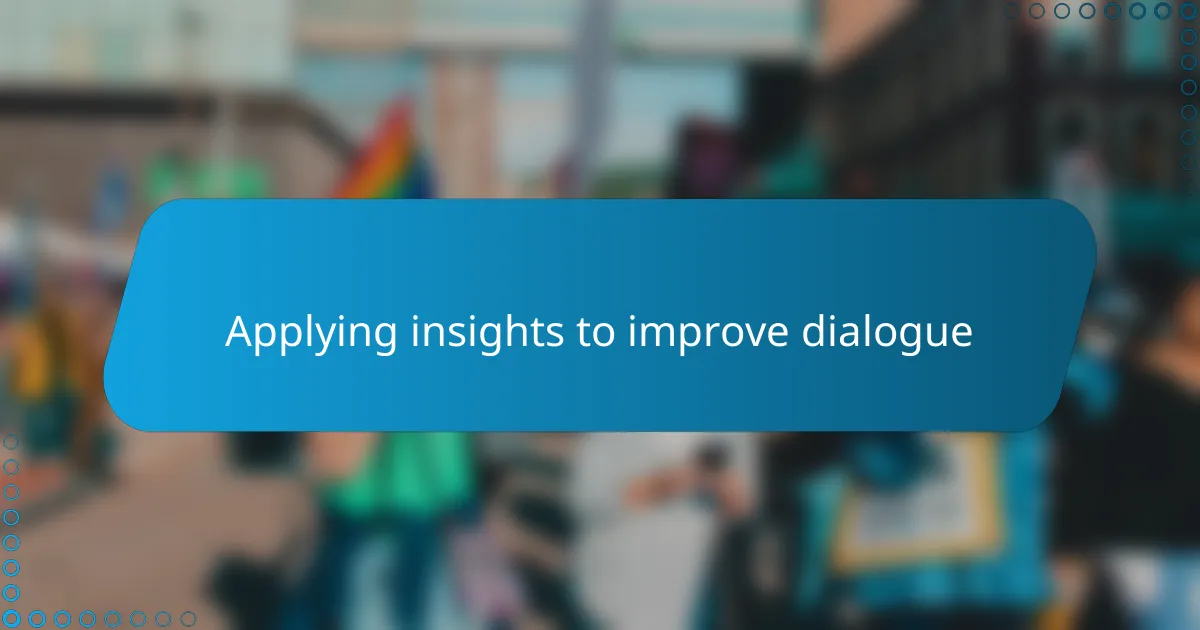
Applying insights to improve dialogue
Applying these insights has transformed how I approach polarized discussions. Instead of diving straight into disagreement, I now try to listen deeply and understand where someone is coming from, which often shifts the tone from confrontation to curiosity. Have you noticed how simply acknowledging someone’s perspective can soften even the toughest exchanges?
I’ve also found it helpful to ask myself what common ground exists before jumping into debate. Focusing on shared values feels like a bridge, grounding the conversation in mutual respect rather than division. Isn’t it surprising how looking for what unites us can be more productive than highlighting differences?
Of course, it’s not always easy to apply these lessons in the moment. There’s a real emotional challenge in resisting the urge to defend or attack. But I remind myself that walking away or pausing isn’t giving up; it’s creating space for dialogue that might come later—sometimes that patience is the most powerful tool we have.
